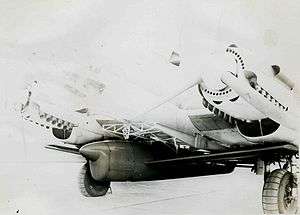Fieseler Fi 157
| Fieseler Fi 157 | |
|---|---|
 | |
| An un-powered Fi 157 ready for drop trials from its He 111B mother-ship. | |
| Role | Unmanned anti-aircraft target drone |
| Manufacturer | Fieseler |
| First flight | 1937 |
| Number built | 3[1] |
|
| |
The Fieseler Fi 157 was an unsuccessful attempt at developing a radio-controlled, full-sized anti-aircraft target.
Development
In 1937, the Reichsluftfahrtministerium (RLM) contracted Fieseler to produce a radio controlled anti-aircraft target drone. The resulting Fi 157 was a low-wing monoplane of entirely wooden construction and was carried beneath a bomber before being released. All three prototypes crashed during testing; a single example of a manned version, designated Fi 158, was built to investigate remote guidance.[1][2]
Specifications (Fieseler Fi 157)
Data from [3]
General characteristics
- Length: 5.86 m (19 ft 3 in)
- Wingspan: 6.5 m (21 ft 4 in)
- Wing area: 5.9 m2 (64 sq ft)
- Empty weight: 226 kg (498 lb)
- Gross weight: 309 kg (681 lb)
- Powerplant: 1 × Hirth Motoren HM 60 4-cyl. inverted air-cooled in-line piston engine, 119 kW (160 hp)
Performance
- Maximum speed: 293 km/h (182 mph; 158 kn)
- Range: 580 km (360 mi; 313 nmi)
See also
- Related development
Notes
References
- Green, William. Aircraft of the Third Reich. London: Aerospace Publishing Vol.1. ISBN 978 1 900732 06 2.
- Flying Review International: 65. July 1969. Missing or empty
|title=(help)
Further reading
- Green, William (1970). Warplanes of the Third Reich. Garden City, N.Y.: Doubleday. ISBN 0385057822.
- L, Antony L..; Creek, Antony L. Kay; with drawings by E.J. (1972). German aircraft of the Second World War. London: Putnam & Company Limited. ISBN 0370000242.
- Wood, Tony; Gunston, Bill (1997). Hitler's Luftwaffe. London: Salamander Books. ISBN 051718771X.
External links
| Wikimedia Commons has media related to Fieseler Fi 157. |
This article is issued from Wikipedia - version of the 9/11/2015. The text is available under the Creative Commons Attribution/Share Alike but additional terms may apply for the media files.